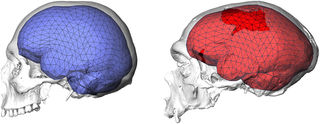Christopher Bergland in Psychology Today:
 In recent months, there’s been a groundswell of evidence showing that more volume in both the left and right hemispheres of the cerebellum (Latin for “little brain”) may be linked to Homo sapiens’ evolutionary success in comparison to Neanderthals, who inhabited Ice-Age Europe about 250,000 to 40,000 years ago.
In recent months, there’s been a groundswell of evidence showing that more volume in both the left and right hemispheres of the cerebellum (Latin for “little brain”) may be linked to Homo sapiens’ evolutionary success in comparison to Neanderthals, who inhabited Ice-Age Europe about 250,000 to 40,000 years ago.
In January 2018, researchers from the Department of Human Evolution at the Max Planck Institute in Leipzig reported that the bulging of the cerebellar hemispheres played a significant role in giving present-day human brains a more globular shape in comparison to Neanderthals, who had a more elongated endocranial shape. This paper, “The Evolution of Modern Human Brain Shape(link is external),” was published in Scientific Advances.
Now, a new paper, “Reconstructing the Neanderthal Brain Using Computational Anatomy(link is external),” published on April 26 in the journal Scientific Reports, also shows that early Homo sapiens had bigger cerebellar hemispheres than Neanderthals. The multidisciplinary team of researchers speculates that the extinction of Neanderthals and the expansion of Homo sapiens may be tied to cerebellum size.
More here.
